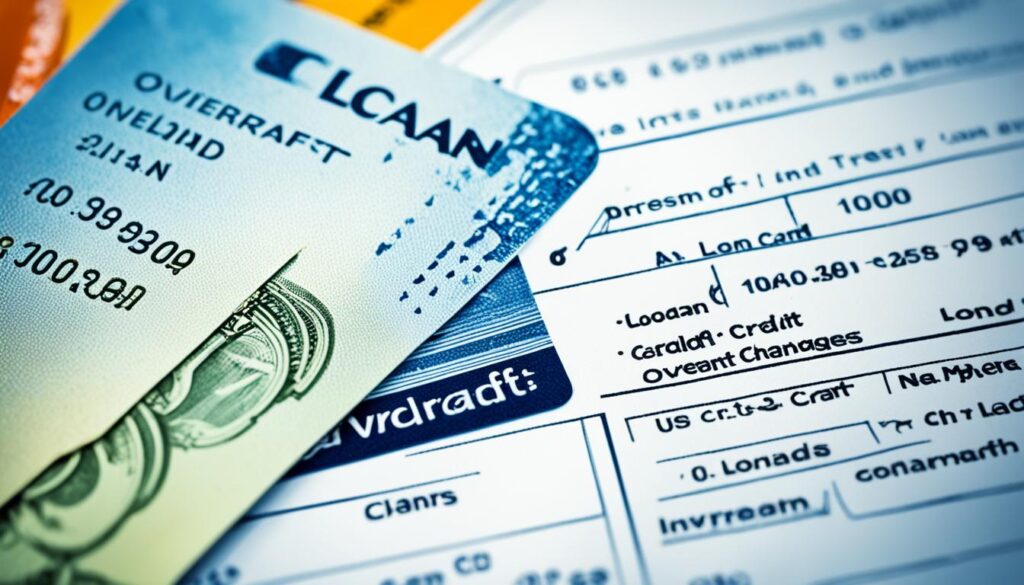An overdraft happens when a business bank account doesn’t have enough money for transactions. It’s a tool for managing cash flow and covering unexpected costs. The overdraft gives businesses the ability to use a set amount of extra funds.
For companies needing help with cash flow or unforeseen bills, an overdraft is perfect. It lets them use extra money easily. This is key for daily tasks and sudden expenses.
Key Takeaways:
- A business overdraft is a flexible financing solution used for managing cash flow and unexpected expenses.
- It provides a revolving line of credit that allows businesses to draw funds up to an approved limit.
- Businesses can use the overdraft to cover day-to-day operations and handle unforeseen costs.
- Having a business overdraft provides businesses with the necessary liquidity to navigate uncertain financial situations.
- Business overdrafts are versatile and cater to the varying needs of different businesses.
How Does a Business Overdraft Work?
A business overdraft is a flexible way for companies to borrow money up to an agreed limit. It lets them pay interest only on what they use. This can save money when covering costs like employee wages, supplier bills, or buying stock.
Businesses can take out funds as they need them with an overdraft. This is great for managing ups and downs in cash flow or meeting short-term bills. The process for getting funds is quick and simple, helping companies deal with different financial needs.
The interest on an overdraft is based on the money a business takes out. So, they don’t pay interest on the full limit, just what they actually use. This keeps costs down and helps companies use their money wisely.
Let’s say a business has a $50,000 overdraft limit. If they draw $10,000 for wages and bills, they’ll only pay interest on that $10,000. This is better than paying for the whole $50,000.
Business overdrafts let companies deal with quick money needs without long-term loans or complicated routes. They offer a quick way to get funds, which helps businesses stay strong and flexible. This way, they can seize chances or handle tough times.

| Benefits of a Business Overdraft | Covered Expenses |
|---|---|
| Flexibility in accessing funds | Covering employee wages |
| Cost-effective interest rates | Settling supplier invoices |
| Easy and quick access to finance | Stock purchases |
| Managing cash flow fluctuations | Handling unexpected operating expenses |
A business overdraft helps companies by letting them pay interest only on what they use. This way, they have the money they need, whenever they need it. It’s good for covering many costs and keeping cash flow healthy.
Why Use a Business Overdraft?
A business overdraft is a key financial tool that has many benefits for businesses. It helps them deal with sudden expenses or fill short-term cash flow gaps. This financial backup gives companies quick access to funds they require.
Quick Access to Finance
Businesses need funds fast sometimes. An overdraft can offer this swift financial help. It’s great for handling surprise costs or gaps in cash flow. Having an overdraft means companies always have money ready when they need it.
Working Capital Management
Working capital keeps a business alive every day and helps it grow. An overdraft is a smart way to manage this capital well. It acts as a flexible credit line, helping companies pay their bills and jump on new opportunities.
No Need for a Separate Line of Credit
One big plus of an overdraft is that it merges regular business accounts with financial help. This means companies don’t have to deal with extra applications or paperwork. It saves them time and makes their financial backup easier to use.
Utilizing a business overdraft provides businesses with the necessary financial flexibility to navigate unexpected challenges and seize growth opportunities.
To show the benefits of a business overdraft clearly, we’ve put together a table:
| Benefits of a Business Overdraft |
|---|
| Quick access to finance |
| Working capital management |
| No need for a separate line of credit |
The table highlights how a business overdraft can improve a company’s financial situation.
If your company needs quick funds, better management of working capital, and no hassle of a new line of credit, then a business overdraft may be just what you’re looking for.

Pros and Cons of a Business Overdraft
Before using a business overdraft, it’s wise to consider its pros and cons. Let’s look at what it offers and what you should be cautious about.
Pros of a Business Overdraft
- Manage Uneven Cash Flow: It acts as a safety net when cash flow is irregular, helping businesses pay bills when money from clients is late.
- Meet Expenses: Businesses use it to cover essential costs before client payments arrive, keeping daily tasks running smoothly.
- Seize Business Chances: It’s perfect for grabbing quick deals, like discounted stock, or for investing in needed equipment, offering instant funds for such opportunities.
- Handle Unexpected Operating Expenses: For surprises like a broken machine or crucial repairs, a business overdraft is there to help cover the costs.
Cons of a Business Overdraft
- Not Ideal for Long-Term Buys: It’s great for quick financial boosts but not for large, ongoing expenses or investments.
- May Give a False Sense of Safety: Relying too much on it might hide issues with steady cash flow, setting you up for harder financial times later.
Knowing both sides of a business overdraft helps in making smart choices about managing finances and dealing with sudden costs.
Secured vs Unsecured Business Overdraft
It is crucial to know the difference between a secured and unsecured business overdraft. Each type offers specific advantages and points to consider. Let’s dive into these further.
Secured Overdraft
A secured overdraft means the business must put up assets as security. This can be property, goods, or money owed to the business. These assets act as a “safety net” if the loan can’t be paid back. The lender can use these assets to cover the loan if needed.
This kind of overdraft can be better for businesses in some ways. It can let them borrow more money, as the lender is more secure with the assets. Also, the interest rates on these loans might be lower. That’s because the lender faces less risk, thanks to the business’s assets backing the loan.
Unsecured Overdraft
In contrast, an unsecured overdraft doesn’t need any assets as security. It’s all about how trustworthy the business is from a financial point of view. This type of loan might be easier to get, but it often means higher interest rates for the business.
Even with the higher interest rates, there are good things about unsecured overdrafts. They are quick to access. This means businesses can use them for short-term cash flow problems without a long wait or paperwork for the loan to be approved.
When deciding between a secured and unsecured overdraft, it’s wise to think about your business. Consider your financial health and how much risk you are comfortable with. Knowing the benefits and drawbacks of each type helps you make a smart choice.
Key Points:
- A secured business overdraft requires assets as security for the loan.
- Secured overdrafts offer a larger line of credit and lower interest rates.
- An unsecured business overdraft does not require collateral.
- Unsecured overdrafts have higher interest rates but offer flexibility and convenience.
Having looked at both secured and unsecured overdrafts, let’s move on to applying for one in the next section.
Applying for a Business Overdraft
Need funds for your business? A business overdraft is a great choice. With NAB QuickBiz, businesses can apply online for up to $50,000 with ease. You’ll get a fast response. If approved, your money can be available next business day.
Getting a NAB QuickBiz overdraft is simple. Just offer the needed info and documents. Our team will quickly look over your details. We know each business is different. So, we have options to fit various financial needs.
For more info or different overdraft options, check our website. Or, talk to a NAB Business Banker. They can give advice based on your unique business goals.
Take charge of your cash flow with NAB QuickBiz. Apply for a business overdraft. Reach new heights for your business with the right financial support.

Applying for a Business Overdraft: Step-by-Step Guide
- Visit the NAB QuickBiz website.
- Click on the “Apply Now” button.
- Fill in your business details like revenue and desired overdraft amount on the application form.
- Upload important documents such as financial statements.
- Submit your application and await our response.
- If approved, check and agree to the terms and conditions.
- After accepting, you’ll get the funds in your business account.
Applying is straightforward with NAB QuickBiz. It’s the key to supporting your business dreams and grabbing new opportunities. Apply today and get funding as soon as the next business day.
Business Overdraft vs Credit Card vs Loan
Managing your business money wisely is key. It’s important to know how these options differ in interest charges. We’ll look at a business overdraft, a credit card, and a loan to guide your choice based on what your business needs.
Business Overdraft
A business overdraft acts as a credit line for your account. You can borrow when your balance goes below zero. It charges interest only on the borrowed amount. This makes it great for covering surprises or filling short cash gaps. With this, you control when and how much you pay interest.
Credit Card
Credit cards let you delay full payment and they charge interest on what you owe. This can work well for short-term costs. But remember, interest builds if you don’t pay off the total each month. And if you take cash out, the interest is usually higher. To keep costs down, pay your credit card off every month.
Loan
Loans come with a set interest rate and repayment plan. They’re good for big, planned expenses because you know exactly what to pay back over time. Loans often have lower interest rates than credit cards. But getting one can be more work; you usually need something to secure it and a detailed application process.
Thinking about how interest works for each option, pick what fits your business best. Don’t forget to check the details, like interest rates and terms, before deciding.
Here is a summary table to help you remember the main points:
| Option | Interest Charges | Account Balance | Outstanding Balance |
|---|---|---|---|
| Business Overdraft | Charged when below zero Typically on outstanding balance only |
Can drop below zero | The amount borrowed |
| Credit Card | Purchase interest for unpaid balances Cash advance interest for withdrawals |
Can be negative or positive | Total outstanding balance |
| Loan | Fixed interest rate | N/A | Principal loan amount |

Overdraft Plans for Accidental Overdrafts
Accidental overdrafts can cause unexpected fees for businesses. Luckily, overdraft plans can prevent these and ensure smooth transactions. They automatically move funds to stop overdraft fees.
These plans aim to give businesses peace of mind. They stop accidental overdrafts from causing financial trouble. Funds from another account are moved automatically.
Overdraft plans detect when an account might overdraft. They move funds if the balance is too low, preventing issues. This saves businesses the trouble of watching their accounts closely.
These plans not only avoid fees but also make financial management easier. With funds moved automatically, businesses can operate smoothly. They don’t have to worry about extra charges.
The key advantage of these plans is how easy they are to set up. Businesses can do this with their bank. They then don’t have to stress about fees or balance watching.
Using these plans, businesses can focus on their core activities. They don’t have to worry about overdrafts. This helps them keep their finances in order smoothly.
By utilizing overdraft plans, businesses can prevent accidental overdrafts and subsequent fees, ensuring smooth transactions and peace of mind.
Overdraft plans offer peace of mind against accidental overdrafts. Setting up a plan with a bank helps avoid fees. This way, business operations stay uninterrupted.
Different Types of Overdraft Solutions
Managing finances for your business has several options. Two common choices are the Overdraft Line of Credit and the Savings Overdraft Transfer. Let’s dive into what each one offers.
Overdraft Line of Credit
The Overdraft Line of Credit is easy and automatic. It moves money from a credit line to your business to cover costs. It gives you the freedom to reach your funds up to your limit.
It offers various ways to pay your balance. You can opt for minimum payments or clear the debt entirely. Be ready for any costs, like interest fees.
Savings Overdraft Transfer
The Savings Overdraft Transfer is a cost-free choice. It moves money from your savings to avoid overdraft fees on your business account.
Linking your savings and business accounts gives comfort. This setup keeps your business running without sudden payment hurdles.
Choosing between the two depends on your business’s needs. Understand the limits, payments, and possible charges. Make a choice that fits your financial strategy.
Conclusion
A business overdraft is a flexible way for companies to manage their cash. It lets them use extra money quickly when needed. This keeps things moving smoothly without the hassle of applying for another loan.
Before using an overdraft, companies should look at both its good and bad points. It’s great for short-term money needs but not for big, long-lasting payments. Knowing the kind of overdrafts out there helps pick what fits their business best.
Overall, a business overdraft is a handy tool for dealing with changing money situations. It’s there for quick funding, helping companies stay on top of their financial game.
FAQ
What is a business overdraft?
A business overdraft is like a credit line for companies. It lets businesses borrow money up to a set limit. This funding tool is great for dealing with cash shortages and sudden costs.
How does a business overdraft work?
Businesses pay interest only on what they use from the overdraft. This money can go towards various needs like paying employees or buying stock. They don’t pay interest on the limit, just the amount they use.
Why use a business overdraft?
It gives quick cash for business needs, which boosts decision-making confidence. Plus, there’s no need for a new credit line. Businesses can use it with their current transaction account.
What are the pros and cons of a business overdraft?
Overdrafts help with short-term cash needs and let companies grab fast opportunities. They also handle surprises well. But, they’re not for long-term financing. They might mask ongoing cash flow problems.
What is the difference between a secured and unsecured business overdraft?
A secured overdraft needs assets as security. An unsecured one doesn’t, but it can have higher interest rates. This higher rate is because it’s riskier for the lender.
How can I apply for a business overdraft?
Applying online for a NAB QuickBiz overdraft is straightforward for amounts up to ,000. If you get approval, the money is ready the next work day. Businesses can also look into other plans or get advice from a NAB Business Banker.
How does a business overdraft compare to a credit card or loan?
Overdrafts get paid interest on owed balances only. Credit cards have different rates for purchases and cash withdrawals. Loans have fixed rates and terms. Picking the best one depends on your business’s financial needs.
Are there overdraft plans available to prevent accidental overdrafts?
Yes, there are plans to avoid accidental overdrafts and the fees they bring. These plans move money from another account to cover overdrafts. This way, business transactions can proceed without extra charges.
What are the different types of overdraft solutions?
One solution is to have a line of credit that auto-covers debits. There are also savings account transfers to prevent overdrafts for free. Each has its own limits and payment schemes.
In conclusion, what is a business overdraft?
A business overdraft is a smart way for companies to handle short-term financial needs. It’s fast, boosts confidence in decisions, and may eliminate the need for new credit. Learning the options helps companies manage their money better.



















